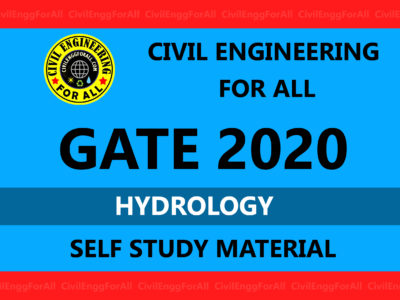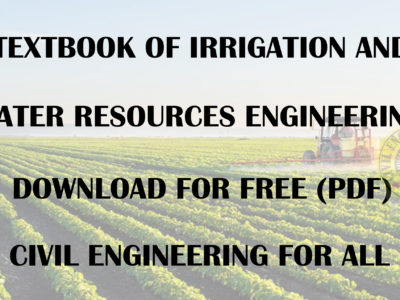
TOPICS COVERED
INTRODUCTION TO HYDROLOGY
Hydrologic Cycle
Water Budget Equation
Water Balance
Applications in Engineering
PRECIPITATION
Forms of Precipitation
Characteristics of Precipitation
Measurement of Precipitation
Raingauge Network
Presentation of Rainfall Data
Mean Precipitation over an area
Frequency of Point Rainfall
Rainfall Data
ABSTRACTIONS FROM PRECIPITATION
Evaporation process
Evaporimeters
Analytical Methods of Evaporation Estimation
Transpiration
Evapotranspiration
Interception
Infiltration
Measurement of Infiltration
STREAMFLOW MEASUREMENT
Measurement of Stage and Velocity
Area-Velocity Method
Dilution Technique
Electromagnetic Method
Ultrasonic Method
Indirect Methods
Stage Discharge Relationship
Extrapolation of Rating Curve
Hydrometry Stations
RUNOFF
Hydrograph
Runoff Characteristics of Streams
Runoff Volume
Flow-Duration Curve
Flow-Mass Curve
Sequent Peak Algorithm
Droughts
HYDROGRAPHS
Factors affecting Flood Hydrograph
Components of Hydrograph
Base Flow Separation
Effective Rainfall
Unit Hydrograph
Distribution Graph
Synthetic and Instantaneous Unit Hydrograph
FLOODS
Rational Method
Empirical Formulae
Unit Hydrograph Method
Flood Frequency Studies
Gumbels Method
Log-Pearson Type III Distribution
Design Flood, Design Storm
Risk, Reliability, Safety Factor
FLOOD ROUTING
Basic Equations
Hydrologic storage routing
Attenuation
Hydrologic Channel Routing
Clarks Method
Nash Method
Flood Control
GROUNDWATER
Forms of Subsurface Water
Aquifer Properties
Compressibility of Aquifers
Equation of Motion
Wells
Steady Flow into a well
Open Wells
Well Loss
Specific Capacity
Recharge
Groundwater Resource
EROSION AND RESERVOIR SEDIMENTATION
Erosion Processes
Estimation of Sheet Erosion
Channel Erosion
Movement of Sediment from Watersheds
Sediment Yield from Watersheds
Trap Efficiency
Life of a Reservoir
Density of Sediment deposits
Reservoir Sedimentation Control
Problems of Erosion and Reservoir Sedimentation
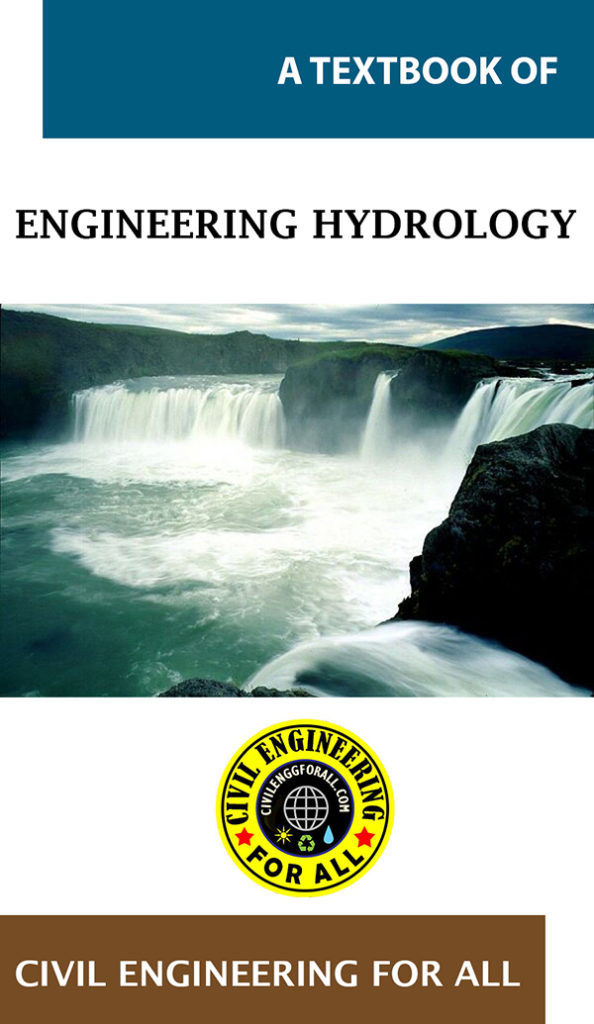
WHAT IS HYDROLOGY
Hydrology means the science of water. It is the science that deals with the occurrence circulation and distribution of water of the earth and earth’s atmosphere, As a branch of earth science, it is concerned with the water in streams and lakes, rainfall and snow fall, snow and ice on the land and water occurring below the earth’s surface in the pores of the soil and rocks. In a general sense, hydrology is a very broad subject of an inter – disciplinary nature drawing support from allied sciences, such as meteorology geology, statistics, chemistry, physics and fluid mechanics. Hydrology is basically an applied science. To further the degree of applicability, the subject is sometimes classified as
1. Scientific hydrology the study which is concerned chiefly with academic aspects
2. Engineering or applied hydrology a study concerned with engineering applications. In a general sense engineering hydrology deal with
(i) estimation of water resources,
(ii) the study of processes such as precipitation, runoff, evapotranspiration and their interaction and
(iii) the study of problems such as floods and droughts, and strategies to combat them.
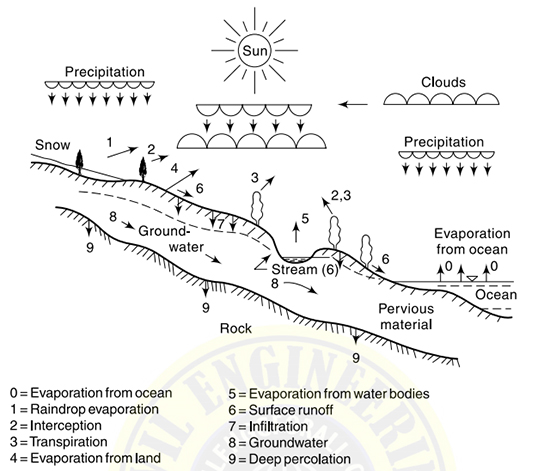
HYDROLOGIC CYCLE
Water occurs on the earth in all its three states, viz. liquid, solid and gaseous, and in various degrees of motion. Evaporation of water from water bodies such as oceans and lakes, formation and movement of clouds, rain and snowfall, streamflow and groundwater movement are some examples of the dynamic aspects of water. The various aspects of water related to the earth can be explained in terms of a cycle known as the hydrologic cycle.
A convenient starting point to describe the cycle is in the oceans. Water in the oceans evaporate due to the heat energy provided by solar radiation. The water vapour moves upwards and forms clouds. While much of the clouds condense and fall back to the oceans as rain, a part of the clouds is driven to the land areas by winds. There they condense and precipitate onto the land mass as rain, snow, hail, sleet, etc. A part of the precipitation may evaporate back to the atmosphere even while falling. Another part may be intercepted by vegetation, structures and other such surface modifications from which may be either evaporated back to atmosphere or move down to the ground surface, A portion of the water that reaches the ground enters the earth’s surface through infiltration, enhance the moisture content of the soil and reach the groundwater body. Vegetation sends a portion of the water from under the ground surface back to the atmosphere through the process of transpiration.
HYDROLOGY IES MASTER GATE MATERIAL : CLICK HERE
The precipitation reaching the ground Surface after meeting the needs of infiltration and evaporation moves down the natural slope over the surface and through a network of gullies, streams and rivers to reach the ocean. The groundwater may come to the surface through springs and other outlets after spending a considerably longer time than the surface flow. The portion of the precipitation which by a variety of paths above and below the surface of the earth reaches the stream channel is called runoff. Once it enters a stream channel, runoff becomes stream flow. । | The sequence of events as above is a simplistic picture of a very complex cycle that has been taking place since the formation of the earth. It is seen that the hydrologic cycle is a very vast and complicated cycle in which there are a large number of paths of varying time scales. Further, it is a continuous recirculating cycle in the sense that there is neither a beginning nor an end or a pause. Each path of the hydrologic cycle involves one or more of the following aspects
(i) transportation of water,
(ii) temporary storage and
(iii) change of state.
For example, (a) the process of rainfall has the change of state and transportation and (b) the groundwater path has storage and transportation aspects

HYDROLOGY AND IRRIGATION MADE EASY GATE NOTE : CLICK HERE
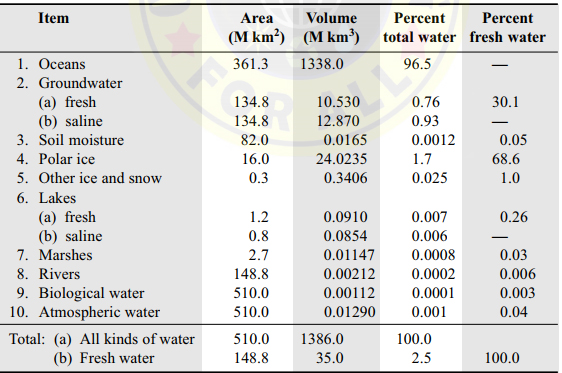
PRECIPITATION
The term precipitation denotes all forms of water that reach the earth from the atmosphere, The usual forms are rainfall, snowfall, hail, frost and dew, Of all these, only the first two contribute significant amounts of water. Rainfall being the predominant form of precipitation causing stream flow, especially the flood flow in a majority of rivers in India, unless otherwise stated the term rainfall is used in this book synonymously with precipitation. The magnitude of precipitation varies with time and space. Differences in the magnitude of rainfall in various parts a country at a given time and variations of rainfall at a place in various seasons of the year are obvious and need no elaboration, this variation that is responsible for many hydrological problems, such as floods and droughts. The study of precipitation forms a major portion of the Subject of hydrometeorology. In this chapter, a brief introduction is given to familiarize the engineer with important aspects of rainfall, and, in particular, with the collection and analysis of rainfall data.
HYDROLOGY ACE GATE NOTES : CLICK HERE
For precipitation to form-
(i) the atmosphere must have moisture,
(ii) there must be sufficient nuclei present to aid condensation,
(iii) Weather conditions must be good for condensation of water vapour to take place, and
(iv) the products of condensation must reach the earth.
Under proper weather conditions, the water vapour condenses over nuclei to foreign tiny water droplets of sizes less than 0. 1 mm in diameter. The nuclei are usually salt particles or products of combustion and are normally available in plenty. Wind speed facilitates the movement of clouds while its turbulence retains the water droplets in suspension. Water droplets in a cloud are somewhat similar to the particles in a colloidal suspension. Precipitation results when Water droplets come together and coalesce to for in larger drops that can drop down. A considerable part of this precipitation gets evaporated back to lie atmosphere. The net precipitation at a place and its form depend upon a number of meteorological factors, such as the weather elements like Wind, temperature, humidity and pressure in the Volume region enclosing the clouds and the ground Surface at the given place,
FORMS OF PRECIPITATION – Some of the common forms of precipitation are : rain, snow, drizzle, glaze, sleet and hail.
RAIN
It is the principal form of precipitation in India. The term rainfall is used to describe precipitations in the form of water drops of sizes larger than 0. 5 mm. The maximum size of a raindrop is about 6 mm. Any drop larger in size than this tends to break up into drops of smaller sizes during its fall from the clouds. On the basis of its intensity, rainfall is classified as Light rain, Moderate Rain and Heavy Rain
SNOW
Snow is another important form of precipitation. Snow consists of ice crystals which usually combine to form flakes. When fresh, snow has an initial density varying from 0.06 to 0.15 g/cm and it is usual to assume an average density of 0.1 g/cm. In India, snow occurs only in the Himalayan regions.
HYDROLOGY ACE GATE MATERIAL : CLICK HERE
DRIZZLE
A fine sprinkle of numerous water droplets of size less than 0.5 mm and intensity less than 1 mm/h is known as drizzle. In this the drops are so small that they appear to float in the air.
GLAZE
When rain or drizzle comes in contact with cold ground at around 0°C, the water drops freeze to form an ice coating called glaze or freezing rail.
SLEET
It is frozen raindrops of transparent grains which form when rain falls through air at subfreezing temperature. In Britain, sleet denotes precipitation of snow and rain simultaneously.
HAIL
It is a showery precipitation in the form of irregular pellets or lumps of ice of size more than 8 mm. Hails occur in Violent thunderstorms in which vertical currents are very strong.

EVAPOTRANSPIRATION
While transpiration takes place, the land area in which plants stand also lose moisture by the evaporation of water from soil and water bodies. In hydrology and irrigation practice, it is found that evaporation and transpiration processes can be considered advantageously under one head as evapotranspiration. The term consumptive use is also used to denote this loss by evapotranspiration. For a given set of atmospheric conditions, evapotranspiration obviously depends on the availability of water. If sufficient moisture is always available to completely meet the needs of vegetation fully covering the area, the resulting evapotranspiration is called potential evapotranspiration (PET). Potential evapotranspiration no longer critically depends on the soil and plant factors but depends essentially on the climatic factors. The real evapotranspiration occurring in a specific situation is called actual evapotranspiration (AET).
ENGINEERING HYDROLOGY TEXTBOOK BY CIVILENGGFORALL
DOWNLOAD LINK : CLICK HERE
PASSWORD : CivilEnggForAll
OTHER USEFUL BOOKS
- RAJASTHAN STAFF SELECTION BOARD (RSSB) JUNIOR ENGINEER DIPLOMA CIVIL ENGINEERING EXAM 2022 – HINDI & ENGLISH MEDIUM SOLVED PAPER – FREE DOWNLOAD PDF (CivilEnggForAll.com)
- ISRO TECHNICAL ASSISTANT EXAM 2022 – CIVIL ENGINEERING – HINDI & ENGLISH MEDIUM – SOLVED PAPER – FREE DOWNLOAD PDF (CivilEnggForAll.com)
- MADHYA PRADESH PUBLIC SERVICE (MPPSC) COMMISSION – ASSISTANT ENGINEER EXAM – MPPSC AE 2021 CIVIL ENGINEERING – SOLVED PAPER WITH EXPLANATIONS – PDF FREE DOWNLOAD
- BIHAR PUBLIC SERVICE COMMISSION (BPSC) ASSISTANT ENGINEER EXAM – 2022 – CIVIL ENGINEERING – SOLVED PAPER – FREE DOWNLOAD PDF (CivilEnggForAll.com)
- ODISHA PUBLIC SERVICE COMMISSION – OPSC AEE PANCHAYATI RAJ EXAM 2021 – SOLVED PAPER WITH EXPLANATION – FREE DOWNLOAD PDF









